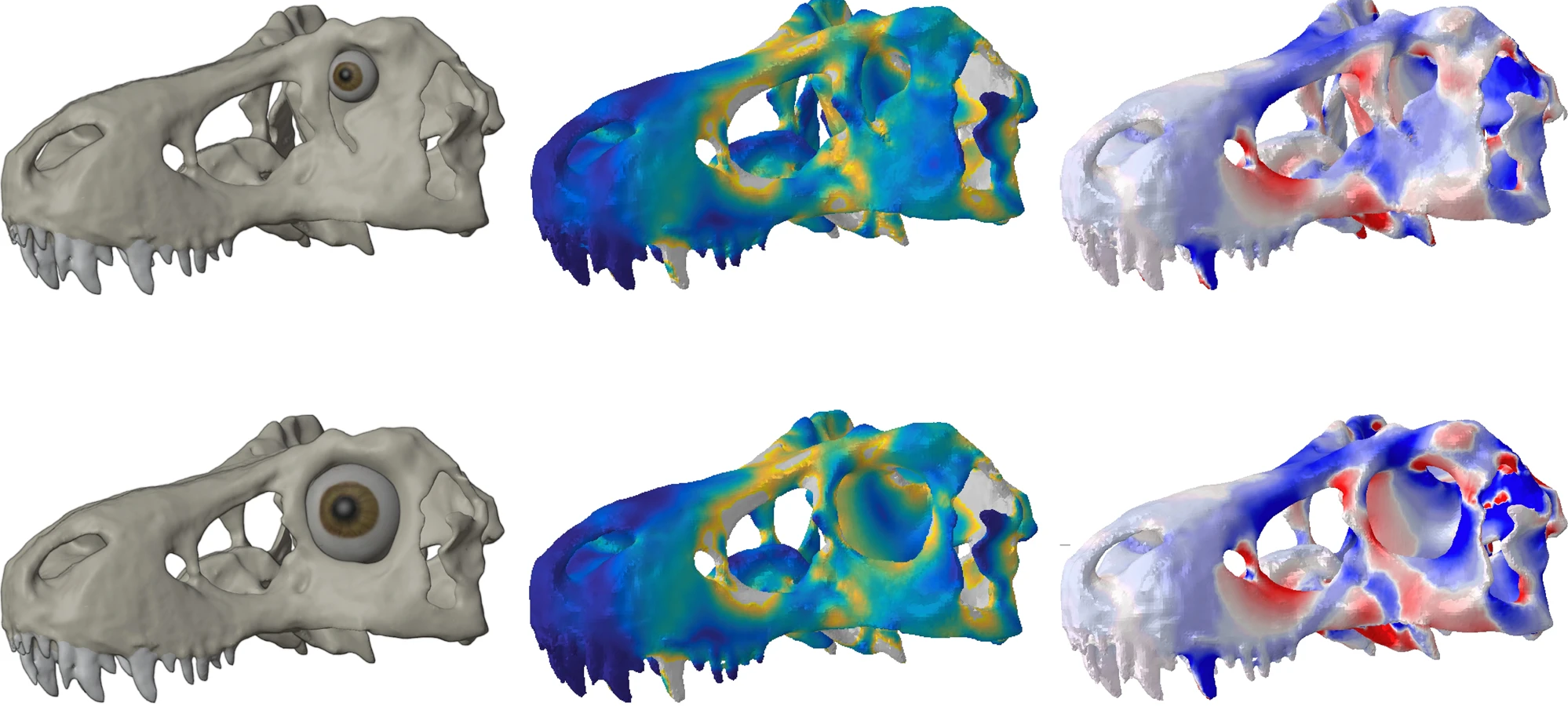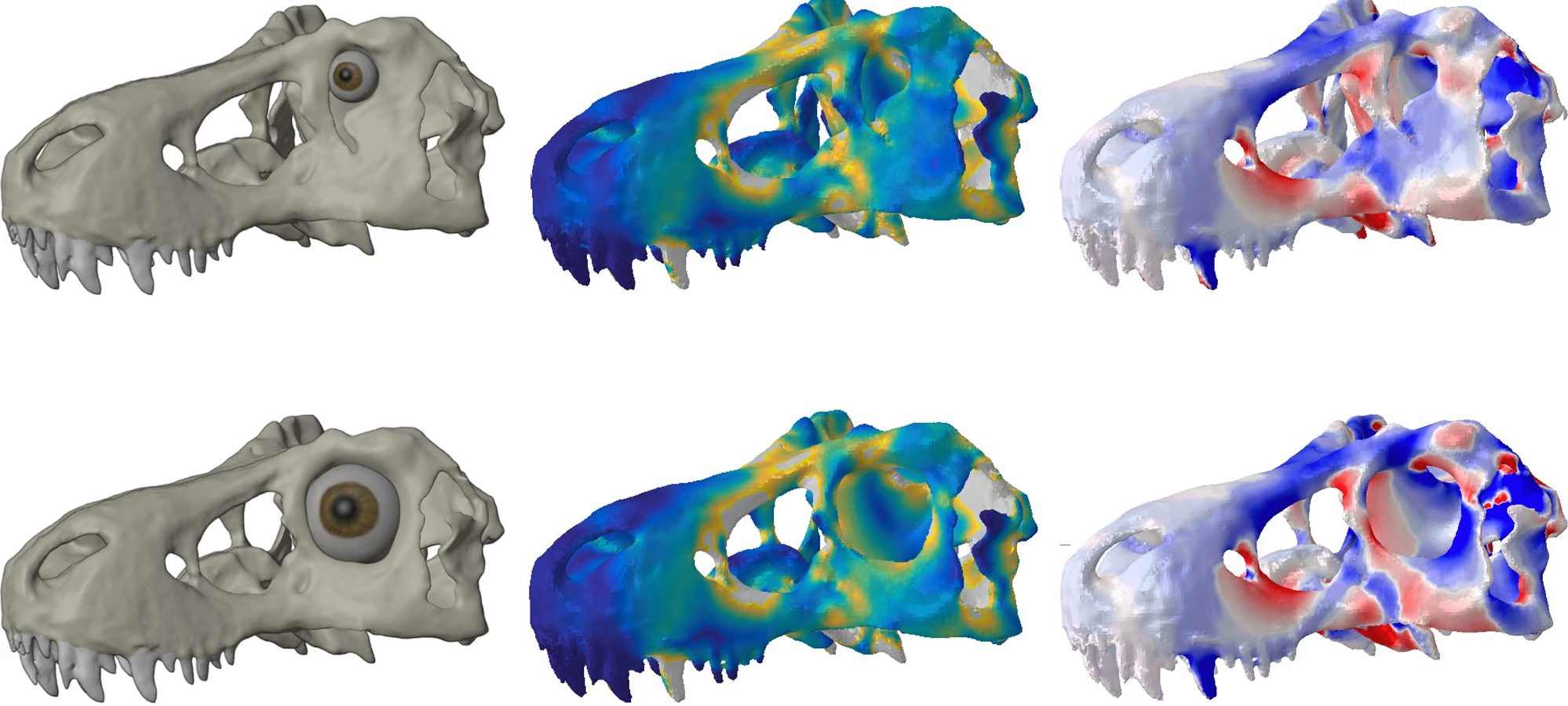Eyes Provide a Window into the Strength of Dinosaur Bites
The Tyrannosaurus rex is famous for its oversized head, huge muscular jaws, and knife-like teeth, which paleontologists think enabled this fearsome predator to easily devour unsuspecting prey. A study from Stephan Lautenschlager now suggests that its eye socket shape was equally important [1]. Analyzing the shapes of the eye sockets of over 400 skulls from dinosaurs and related species, the paleontologist from the University of Birmingham, UK, found that carnivorous dinosaurs, such as the T. rex, glared out at the world through elliptical holes. Simulations indicate that these elongated holes would have allowed a T. rex’s skull to withstand the significant bite forces that these prehistoric creatures generated when they chomped down.
For his study, Lautenschlager used a technique from facial recognition technologies to characterize the shapes of the outlines of each eye socket in his dinosaur-skull sample. These shapes were then analyzed with a finite-element-analysis tool—a method commonly used to predict how an object reacts to a force—to see how they deformed when subjected to the various stresses emanating from a bite.
Considering eye socket shape, Lautenschlager found that most of the species in his study looked through circular openings, similar to the round socket outlines observed in human skulls. A few species, including the T. rex and the Skorpiovenator, a carnivorous dinosaur found in Antarctica, had socket outlines with more unusual shapes, ranging from simple ellipsoids to lobed patterns. “The Skorpiovenator eye socket is essentially separated into two,” giving it an hourglass-like outline, Lautenschlager says.
Looking for commonalities among dinosaurs with unusual eye socket outlines, Lautenschlager found that they were all meat eaters with large skulls relative to their body size. During a bite, the jaws of these apex predators snapped together with a force of around 50,000 newtons. The resulting skull stresses could deform an eye socket with a circular outline, according to Lautenschlager’s analysis. A hypothetical T. rex with such a socket would likely have developed thicker bones in the most deformed areas. “That would have made the skull a lot heavier, or impacted on the space for other tissues,” he says. By contrast, a socket with an elongated outline would experience significantly less deformation. “It seems that carnivores evolved sockets that could withstand [bite-related] forces.”
Skull adaptations in dinosaur behemoths aren’t all that unexpected, Lautenschlager admits, but his analysis did throw up one surprise. Unlike its parents, a baby T. rex had sockets with circular outlines and only developed ones with elongated shapes at around 10 years—the age at which paleontologists consider the T. rex to have transitioned into adulthood. “That hints that a baby T. rex didn’t need a socket that was as stable,” he says. The finding ties in with other studies suggesting that T. rex juveniles and adults had different diets.
Researchers have long been aware of peculiar eye socket shapes in archosaurs, a group of animals that includes dinosaurs, birds, and crocodiles. However, previous studies have looked primarily at eyeball diameter or focused on one subset of archosaurs, says Thomas Holtz, a paleontologist at the University of Maryland, College Park. “This [new study] is a vastly more comprehensive look at the evolution of archosaur eye size and shape than has ever been done before,” Holtz says. He is particularly impressed that Lautenschlager incorporated different lines of evidence in the analysis. “It is nice to find reasonable—and mathematically supported—explanations for the particular shapes we find in anatomical structures,” he says.
–Katherine Wright
Katherine Wright is the Deputy Editor of Physics Magazine.
References
- S. Lautenschlager, “Functional and ecomorphological evolution of orbit shape in Mesozoic archosaurs is driven by body size and diet,” Commun. Biol. 5, 754 (2022).





